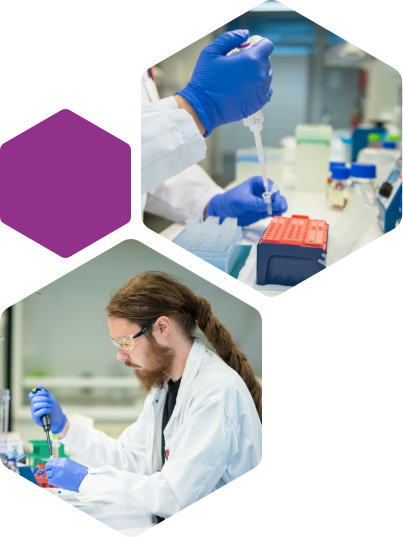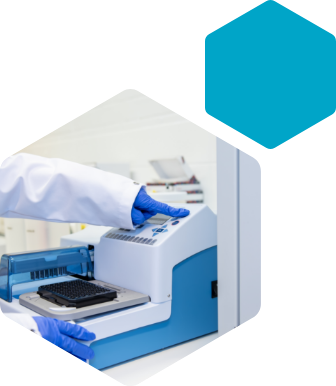Our services for Physicochemistry and Binding research
Physicochemical parameters, such as solubility and lipophilicity, are used as first indicators of “drug-likeness” of a new chemical entity, with respect to absorption from the intestine. Information about these properties is also valuable when planning optimum conditions for other in vitro ADME assays.
Our services are available for small molecules, peptides, and other modalities, such as oligonucleotides.
Evaluation of binding and unbound fraction of the drug in various matrices (e.g., plasma, brain) is in a key role when it comes to distribution of the compound across biological membranes and its availability for metabolic processes. These are important parameters when scaling the processes between various species and predicting in vivo processes based on in vitro assays such as hepatic clearance or CYP inhibition potential.
Our services cover evaluation of physicochemical parameters in buffers or in biorelevant media, as well as evaluation of unbound fraction in biological matrices essential for ADME properties.
Solubility
Only the dissolved fraction of a compound can move through membranes by diffusion or via transporter mechanisms or interact with receptors/enzymes. Solubility is an important parameter in drug development as it is limiting factor for the free-to-interact fraction of the compound in the gastrointestinal fluids, plasma and other matrices in the body.
The solubility of a study compound is determined using either the traditional “shake-flask” –method (thermodynamic solubility) or by spiking DMSO-stock solution into buffer-system (“kinetic” solubility) to minimize the consumption of the study compound. The samples will be filtrated and analyzed by LC-PDA/MS.
Physicochemical parameters, such as solubility, are used not only for the prediction of the compounds’ behavior in vivo, but also planning reliable test conditions for other in vitro assays, and therefore it is important to evaluate solubility in the early stage of drug discovery.
Lipophilicity (logP/D)

Lipophilicity refers to the tendency of a compound to partition between a lipophilic organic phase and a polar aqueous phase. In drug development lipophilicity of a compound is represented either as partition coefficient, logP or distribution coefficient, logD. Since the majority of known drugs are at least partly charged in physiological pH, logD is more accurate descriptor of compound lipophilicity as it describes the partition of both un-ionized and ionized forms of the molecule, whereas logP only describes the partition of un-ionized molecules. Lipophilic compounds generally have a higher permeation across biological membranes than lipophobic compounds improving their oral bioavailability through better absorption in the gastrointestinal tract.
We provide two different methods for determining lipophilicity: a “shake-flask” method (logP/D) and a high throughput RP-HPLC method, which results in an extrapolated logD (ElogD).
With the shake-flask method, the study compound is incubated in a two-phase system under shaking, and samples collected from both phases after equilibration are analyzed with LC-PDA/MS. With the high throughput RP-HPLC method, study compounds are analyzed using three different isocratic RP-HPLC methods. LogD values are determined based on the retention time changes of the compounds and comparison with a series of reference standards.
Physicochemical parameters, such as logP/D, are used not only for the prediction of the compound’s behavior in vivo, but also planning reliable test conditions for other in vitro assays.
EPSA (Experimental Polar Surface Area)
Passive permeability is a key factor driving the absorption from the gut for orally administered compounds as well as can have considerable impact for CNS permeation. While the permeability of a compound can be investigated with in vitro methods such as Caco-2 or MDCK cells, typically, these do not provide reliable results for compounds that don’t follow the Lipinski’s Rule of five, such as cyclic peptides or PROTACs.
As an alternative method for assessing the permeability of compounds, we offer Experimental Polar Surface Area (EPSA) assay. EPSA represents the 3D polar surface area of the molecule in solution, taking into account possible intramolecular hydrogen bonds formed which might decrease polarity and increase permeability. Together with logD data, the balanced permeability index (BMI) can be calculated which distinguishes compounds with high permeability and low efflux, predicting CNS permeability.
Plasma Protein Binding
- Rapid equilibrium dialysis (RED) method for small molecules
- Ultrafiltration method for unstable compounds
- Cross filtration method for larger peptides and biomolecules
- Analysis with LC-MS/MS

Only the free unbound fraction of a compound in blood circulation is able to diffuse or be transported through biological membranes, or to interact with receptors and enzymes. In order to make accurate in vivo predictions, it is important to evaluate the degree of binding of a study compound to plasma proteins. The degree of plasma protein binding is also an important parameter in PBPK modelling.
The degree of plasma protein binding of study compounds are elucidated using rapid equilibrium dialysis (RED), ultrafiltration or cross filtration followed by analysis of the samples by LC-MS/MS. Also, TRANSIL high-sensitivity binding assay can be used to measure binding, if the binding is too high to be measured using the traditional methods or if the compound has high non-specific binding resulting in low recovery.
Blood to plasma ratio
Binding to red blood cells affects the partitioning of the compound between blood and plasma and may lead to high blood to plasma ratio. If not taken into account, high blood to plasma ratio may result in incorrect calculation of the pharmacokinetic parameters as they are typically determined by analysis of compound concentrations in the plasma.
The degree of red blood cell binding is elucidated by incubating the study compound in fresh whole blood and plasma. The blood is centrifuged to plasma and the ratio of study compound observed in plasma in comparison to reference plasma sample will be used to calculate red blood cell binding and blood to plasma partitioning ratio. Also, a version with analysis of both plasma and red blood cell fractions is available.
Tissue Binding

According to their physicochemical properties (e.g., lipophilicity and solubility) compounds can bind to different kinds of tissues, such as fat, brain, liver, and kidney, causing accumulation of the compound in the body outside of blood circulation. Accumulation in tissues affects the PK profile of the compound and can prolong the body’s exposure to the compound leading to toxicity.
The degree of tissue binding of study compounds are elucidated using rapid equilibrium dialysis (RED) or ultrafiltration in tissue homogenate, followed by analysis of the samples by LC-MS/MS.
Microsome / Hepatocyte Binding
In addition to binding to plasma proteins, compounds can also bind to microsomes and hepatocytes. Since only the free unbound fraction of the study compound can interact with metabolizing enzymes, microsome/hepatocyte binding can affect the prediction of in vivo pharmacokinetics from in vitro data.
Rapid equilibrium dialysis (RED) or ultrafiltration is used to elucidate the degree of binding of the study compound to microsomes or hepatocytes. This is followed by an analysis of the samples by LC-MS/MS.
Stability in Plasma, Buffer or Biorelevant Media
- FaSSIF, FeSSIF, SIF, SGF
- Identification of degradation products
Stability of new chemical entities in gastric or intestinal fluid may in some cases be a limiting factor of bioavailability, already before the actual absorption across intestinal membranes to blood circulation. Similarly, low plasma stability may cause low levels in circulation, and may affect also to the results from quantitative plasma analysis, if the compound is unstable between sample collection and analytical step. Therefore, the identification of these processes, both qualitatively and quantitatively, is highly important.
